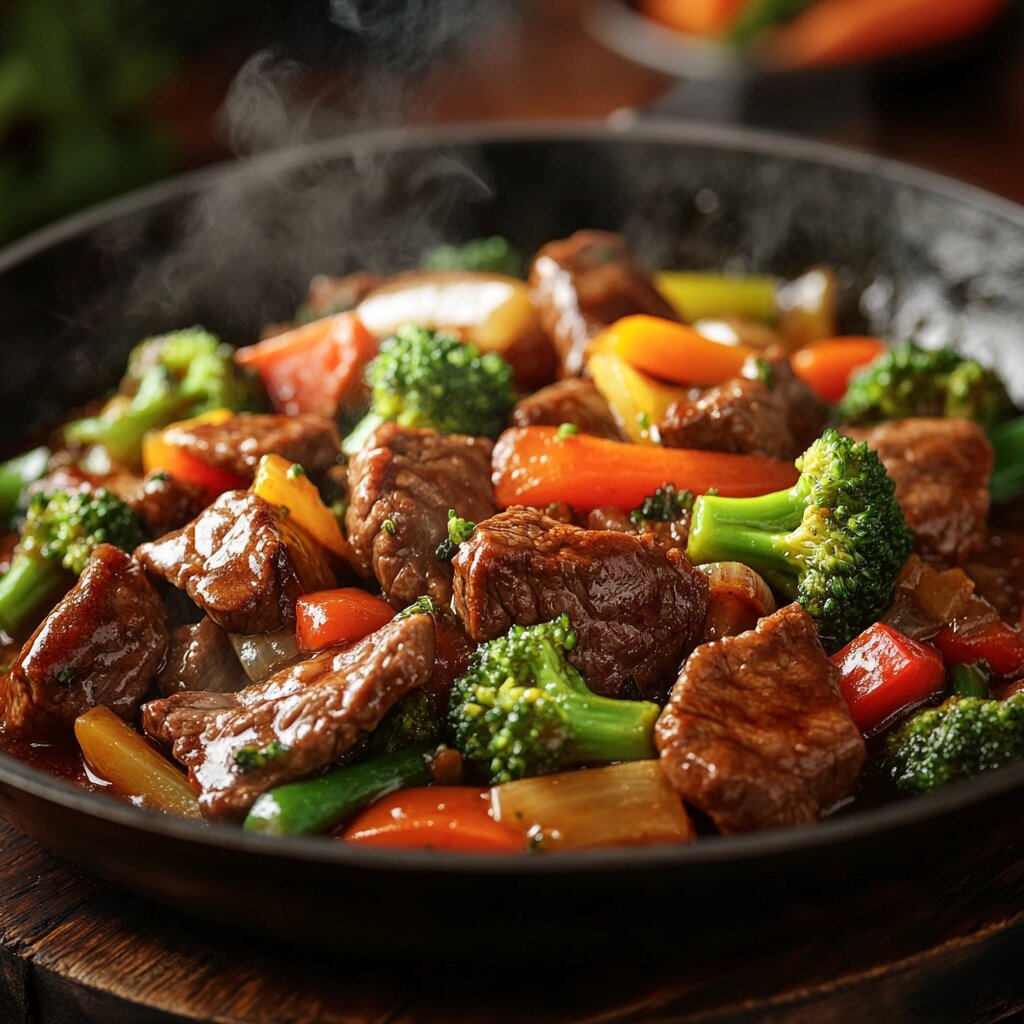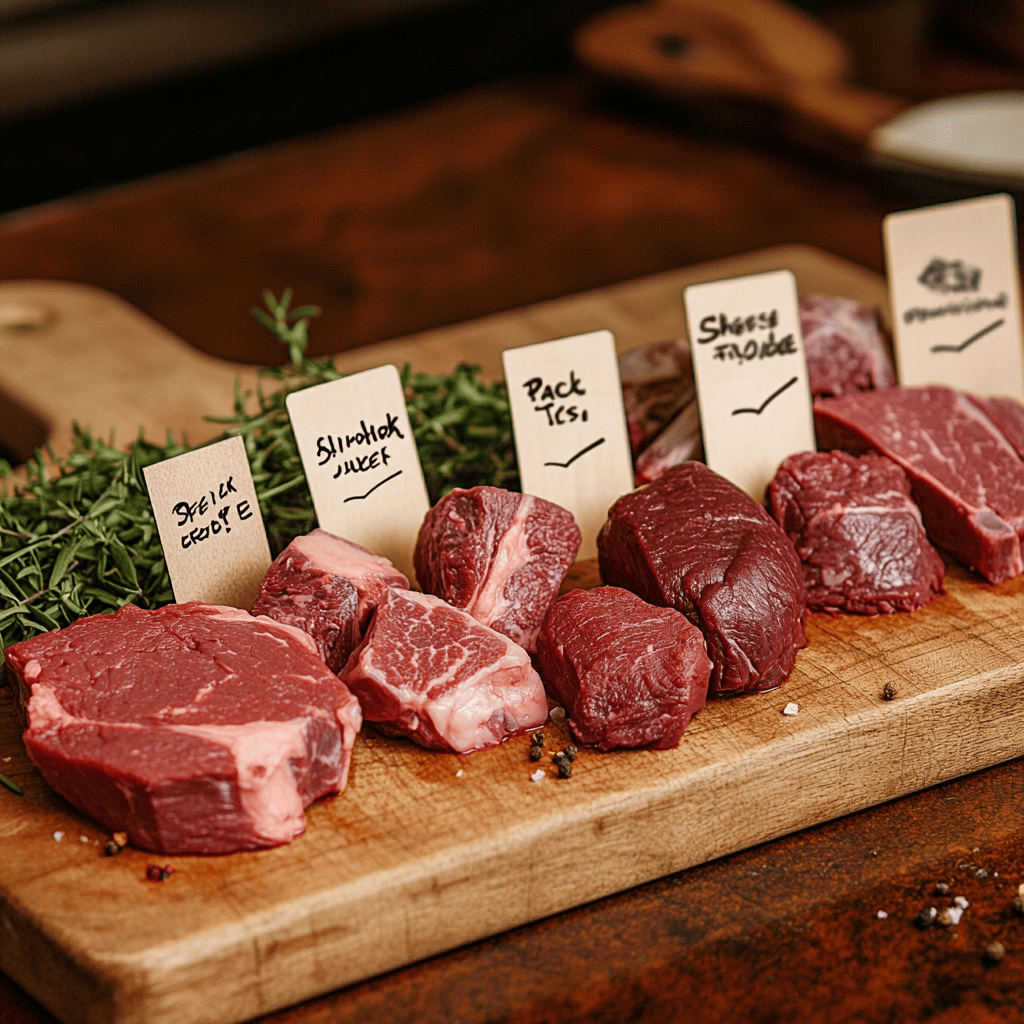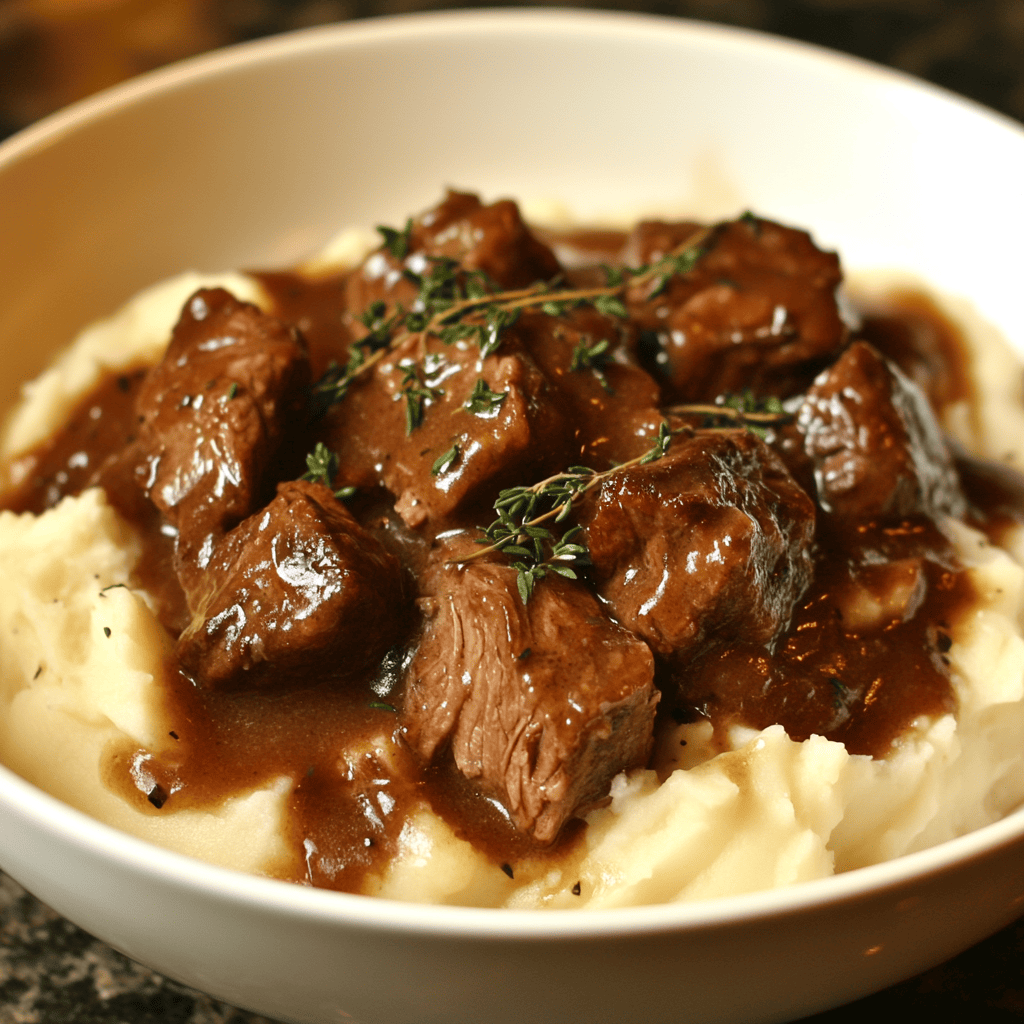
Beef tips refer to small, tender pieces of beef, but what cut of meat are beef tips exactly? They are usually cut from larger roasts or steaks. Typically, butchers source these tips from cuts like sirloin, chuck, or tenderloin. The size and tenderness of the tips depend on the specific cut. Knowing what cut of meat are beef tips helps you select the best cooking method. Because of their versatility, beef tips work well in a variety of dishes, such as stir-fries, stews, and casseroles. When tips come from tender cuts like sirloin or filet mignon, they are perfect for quick-cooking methods. On the other hand, beef tips from tougher cuts, like chuck, benefit from slow cooking. Additionally, the term “beef tips” can describe leftover trimmings from premium cuts, making them an economical choice. Therefore, this flexibility allows home cooks to prepare hearty meals using various techniques and flavor profiles.
Table of Contents
Common Uses of Beef Tips
Beef tips work well in a wide range of recipes. For example, many people enjoy them in stir-fries, where the meat cooks quickly with vegetables and sauces. In Southern cuisine, cooks often slow-cook beef tips in a rich gravy, creating a comforting meal served over rice or mashed potatoes. Additionally, they work well on skewers or kebabs, making them a great choice for grilling. Because the tips are small, they cook faster than whole steaks. Understanding what cut of meat are beef tips can help you plan ideal weeknight dinners. Furthermore, many home cooks use beef tips in soups, stews, or casseroles. Their ability to adapt to different cuisines—such as Asian stir-fries, European stews, and Mexican fajitas—further highlights their versatility.
The Origins of Beef Tips
Historical Background of Beef Tips
The use of beef tips originated from traditional butchery practices. Historically, butchers collected small trimmings left over from larger roasts or steaks and sold them as beef tips. This practice helped reduce waste while offering consumers a lower-cost option for quality meat. During the Great Depression and World War II, beef tips gained popularity because they allowed families to stretch meals while still enjoying protein-rich dishes. Over time, cooks began using beef tips in various ways, from stews to stir-fries. As a result, the convenience and affordability of beef tips made them a staple in home kitchens. Today, they continue to provide a versatile and satisfying meal option.
Regional Variations in Beef Tip Preparation
Different regions offer unique ways of preparing beef tips. For instance, in the Southern United States, cooks often slow-cook beef tips in savory gravy and serve them over rice or potatoes. In contrast, Asian cuisine features beef tips in stir-fries, where the meat is seared quickly with vegetables and soy-based sauces. Similarly, in Mexican cooking, beef tips marinate in lime juice and spices before being grilled or sautéed for tacos or fajitas. Meanwhile, European dishes frequently involve braising beef tips with wine, herbs, and root vegetables to create rich stews. Consequently, these regional techniques highlight the adaptability of beef tips and their ability to fit into various culinary traditions.
Different Cuts of Meat Used for Beef Tips

Sirloin Cuts
When asking what cut of meat are beef tips, sirloin remains a popular choice because of its tenderness and rich flavor. This cut comes from the hindquarter of the cow, located behind the short loin. Typically, butchers divide the sirloin into two sections: top sirloin and bottom sirloin. Both sections provide lean, flavorful meat that works well for quick-cooking recipes. Therefore, sirloin beef tips are perfect for grilling, sautéing, or pan-searing, as they remain juicy when cooked properly. Moreover, these tips can be marinated to enhance their tenderness and flavor. Because sirloin costs less than premium cuts, it offers an affordable option for high-quality beef tips.
Top Sirloin
Top sirloin is one of the best cuts for beef tips because of its fine texture and moderate marbling. This cut, taken from the upper part of the sirloin, remains lean while offering excellent flavor. Consequently, top sirloin tips work well for grilling, sautéing, or broiling. For example, they are ideal for stir-fries, kebabs, or skillet meals. Additionally, a simple seasoning of salt, pepper, garlic, and herbs enhances their natural flavor. Because top sirloin cooks quickly, it’s perfect for busy weeknights. Furthermore, marinating for a short time helps the meat stay tender and flavorful. Ultimately, top sirloin provides a balance of affordability, tenderness, and versatility.
Bottom Sirloin
Bottom sirloin, located in the lower part of the sirloin section, is slightly tougher than top sirloin. Consequently, this cut contains more connective tissue, which means it benefits from marinating or slow-cooking. Therefore, bottom sirloin beef tips work well in stews, braises, or casseroles. To enhance tenderness, marinate the tips with acidic ingredients like vinegar, citrus juice, or yogurt. Additionally, when cooked slowly, bottom sirloin tips develop a rich, savory flavor. As a result, they are perfect for comfort food dishes, such as beef tip tacos, skewers, or hearty casseroles. Thus, this cut offers a budget-friendly way to enjoy flavorful and tender beef tips.
Chuck Cuts
Chuck cuts, sourced from the shoulder area, offer rich, beefy flavor. Because these cuts contain more connective tissue, they require slow cooking to achieve tenderness. Consequently, chuck beef tips work well in braises, stews, and slow-cooked dishes. The marbling in chuck helps the meat stay moist during long cooking times. Therefore, popular dishes for chuck tips include beef stews, pot roasts, and slow-cooked beef with gravy. To achieve the best results, marinate chuck tips before cooking or braise them in a flavorful liquid. In conclusion, the affordability and robust taste of chuck cuts make them an excellent choice for hearty, satisfying meals.
How to Identify Quality Beef Tips
Key Visual and Texture Indicators
When selecting beef tips, it’s important to consider several factors to ensure quality. First, look for a bright red color, which indicates freshness. If the meat appears dull, brownish, or gray, it may be past its prime. Additionally, the texture of the beef tips should feel firm and slightly springy when you press them. On the other hand, avoid beef that feels excessively soft or mushy, as this could suggest spoilage.
Moreover, pay attention to marbling—thin streaks of white fat running through the meat. When considering what cut of meat are beef tips, marbling enhances the flavor and tenderness during cooking. For instance, sirloin and tenderloin tips often contain fine marbling, making them ideal for quick-cooking methods. In contrast, cuts with less marbling, like bottom sirloin, benefit from marinating or slow cooking.
Furthermore, the surface of the beef tips should look moist but not overly wet or slimy. If purchasing pre-packaged beef tips, check the packaging for leaks or tears, as damaged packaging may compromise freshness. Lastly, always check the expiration date to ensure you’re buying the freshest product possible.
USDA Grades and Their Importance
Understanding USDA grades helps you select the best beef tips for your needs. Generally, the USDA assigns grades based on factors like marbling, color, and texture. There are three primary grades to consider: Prime, Choice, and Select.
- Prime beef tips have the highest amount of marbling, offering exceptional tenderness and flavor. Therefore, they work well for grilling or sautéing, delivering a juicy and satisfying result. You often find Prime-grade beef in high-end restaurants or specialty markets.
- Choice beef tips contain moderate marbling, making them a versatile option for most recipes. For example, they work well for both quick-cooking methods and slow-cooked dishes. Choice-grade beef is widely available and offers a good balance between quality and cost.
- Select beef tips have the least amount of marbling. Consequently, they are leaner and may require marinating or slow cooking to achieve tenderness. Nevertheless, Select-grade beef tips can still deliver delicious results when prepared properly.
In summary, knowing the USDA grades allows you to choose beef tips that align with your cooking plans and budget. Ultimately, this knowledge helps you achieve the best possible outcome for your recipes.
How to Properly Prepare Beef Tips
Popular Cooking Methods
Grilling
Grilling beef tips enhances their natural flavor by creating a charred, caramelized exterior. To begin with, preheat your grill to medium-high heat and ensure the grates are clean. Next, season the beef tips with salt, pepper, and your favorite herbs. If desired, marinate the tips for 30 minutes to add extra flavor.
When ready to cook, place the beef tips on the grill and sear them for 2-3 minutes per side. Importantly, avoid overcooking, as this can make the meat tough. After grilling, let the beef tips rest for 5 minutes to allow the juices to redistribute. Finally, serve them with grilled vegetables, rice, or a fresh salad.
Sautéing
Sautéing beef tips is a quick and easy method that delivers great flavor. First, heat a tablespoon of oil or butter in a skillet over medium-high heat. Meanwhile, season the beef tips with salt, pepper, and garlic powder.
Once the skillet is hot, add the beef tips and cook them for 4-5 minutes, stirring occasionally to brown them on all sides. Additionally, you can add onions, mushrooms, or bell peppers for extra flavor. After cooking, deglaze the skillet with wine, broth, or soy sauce to create a rich sauce. Ultimately, sautéed beef tips are perfect for pasta, rice bowls, or as a standalone entrée.
Braising
Braising is ideal for tougher cuts like chuck or bottom sirloin because it breaks down connective tissue. To start, season and brown the beef tips in a skillet over medium-high heat. Next, transfer them to a pot or slow cooker and add a flavorful liquid such as beef broth, wine, or tomato sauce.
Then, include aromatics like onions, garlic, and herbs. Cover and cook on low heat for 2-3 hours until the beef tips become tender. Finally, serve the braised beef tips with mashed potatoes, noodles, or crusty bread. In conclusion, braising results in tender, flavorful beef that’s perfect for comforting meals.
Marinating Techniques for Maximum Flavor
Marinating beef tips enhances their flavor and tenderness, especially for leaner or tougher cuts. To begin, choose a marinade that includes acid, oil, and seasonings. For instance, use vinegar, lemon juice, or yogurt to break down the muscle fibers.
Next, combine the acid with oil, such as olive or sesame oil, which helps keep the meat moist. Add herbs, garlic, soy sauce, or mustard for extra flavor. After preparing the marinade, place the beef tips in a resealable plastic bag or a glass dish and pour the marinade over them.
Then, marinate the beef in the refrigerator for at least 30 minutes or up to 24 hours for tougher cuts. Before cooking, allow the beef tips to come to room temperature. Finally, discard the marinade and cook the beef tips using your preferred method. Ultimately, marinating ensures juicy, flavorful meat in every bite.
Nutritional Benefits of Beef Tips
Protein Content and Health Benefits
Beef tips provide a high-quality source of protein, which is essential for building and repairing muscles. For instance, a 3-ounce serving contains around 22 grams of protein. This makes beef tips a satisfying and nutrient-dense meal option.
In addition to protein, beef tips offer important nutrients like iron, zinc, and B vitamins. Specifically, iron supports healthy red blood cells, while zinc boosts the immune system. Meanwhile, B vitamins aid in energy production and brain function. Furthermore, beef tips from lean cuts like sirloin or tenderloin contain less saturated fat, making them a healthier option.
However, it’s important to enjoy beef tips in moderation and balance them with vegetables, whole grains, and healthy fats. Ultimately, incorporating beef tips into a balanced diet can provide essential nutrients that support overall health.
Comparison to Other Cuts of Beef
When compared to other beef cuts, beef tips offer versatility in both texture and nutritional content. For example, sirloin and tenderloin tips are leaner and contain less fat compared to ribeye or short ribs. Consequently, these cuts provide a healthier option for those watching their fat intake.
On the other hand, chuck beef tips offer more marbling, which enhances flavor but increases calorie content. Nevertheless, these richer cuts are perfect for slow-cooked dishes where tenderness and flavor matter most. Ultimately, beef tips allow you to enjoy the benefits of beef without committing to a specific cut. Therefore, you can easily select cuts that fit your dietary preferences and cooking methods.
Best Recipes for Beef Tips
Beef Tip Stir-Fry Recipe
Ingredients:
- 1 pound beef tips (sirloin or tenderloin)
- 2 tablespoons soy sauce
- 1 tablespoon sesame oil
- 2 cloves garlic, minced
- 1 tablespoon fresh ginger, grated
- 1 red bell pepper, sliced
- 1 cup broccoli florets
- 1 large carrot, julienned
- 2 green onions, chopped
- 2 tablespoons vegetable oil
- 2 tablespoons oyster sauce (optional)
- Steamed rice for serving
Instructions:
- First, in a bowl, marinate the beef tips with soy sauce, sesame oil, garlic, and ginger for at least 30 minutes.
- Next, heat 1 tablespoon of vegetable oil in a wok or skillet over medium-high heat.
- Then, add the beef tips and stir-fry for 3-4 minutes until browned. Remove the beef from the skillet and set it aside.
- After that, add the remaining oil to the skillet and stir-fry the bell pepper, broccoli, and carrot for 4-5 minutes until the vegetables are crisp-tender.
- Subsequently, return the beef tips to the skillet and add the oyster sauce if desired. Stir well to coat everything evenly.
- Finally, sprinkle with chopped green onions and serve the stir-fry hot over steamed rice.
In summary, this stir-fry recipe is a quick and healthy way to enjoy tender beef tips with vibrant vegetables.
Slow-Cooked Beef Tips with Gravy

Ingredients:
- 1 pound chuck beef tips
- 2 tablespoons all-purpose flour
- 1 tablespoon olive oil
- 1 large onion, chopped
- 2 cloves garlic, minced
- 2 cups beef broth
- 1 tablespoon Worcestershire sauce
- 1 teaspoon dried thyme
- 1 bay leaf
- Salt and pepper to taste
- Mashed potatoes or egg noodles for serving
Instructions:
- First, season the beef tips with salt and pepper, then dust them with flour.
- Next, heat the olive oil in a skillet over medium heat. Brown the beef tips on all sides, then transfer them to a slow cooker.
- Meanwhile, in the same skillet, sauté the onion and garlic until they soften. Then, transfer them to the slow cooker as well.
- After that, add the beef broth, Worcestershire sauce, thyme, and bay leaf to the slow cooker. Stir to combine everything.
- Now, cover and cook on low for 6-8 hours, or until the beef tips become tender.
- Finally, remove the bay leaf and adjust the seasoning if necessary. Serve the beef tips and gravy over mashed potatoes or egg noodles.
In conclusion, this slow-cooked beef tips recipe creates a comforting, flavorful meal perfect for a cozy dinner.
Common Mistakes When Cooking Beef Tips
Overcooking or Undercooking
Overcooking beef tips can result in tough, dry meat, while undercooking leaves them chewy and unpleasant. For instance, tender cuts like sirloin or filet mignon are best cooked using quick methods such as sautéing or grilling. Aim for medium-rare to medium doneness, which typically takes 3-5 minutes. On the other hand, tougher cuts like chuck require slow-cooking methods, such as braising, for 2-3 hours to become tender.
Therefore, using a meat thermometer ensures accuracy: 130-135°F for medium-rare, 140-145°F for medium, and 160°F for well-done. Ultimately, understanding the right cooking method for each cut helps you achieve perfect results every time.
Choosing the Wrong Cut
Selecting the right cut of beef for your cooking method is essential. For example, if you plan to sauté or grill, choose tender cuts like top sirloin or tenderloin. These cuts cook quickly and remain juicy. Conversely, if you’re making a stew or braised dish, use tougher cuts like chuck or bottom sirloin. These cuts benefit from slow-cooking methods, which break down the connective tissue and enhance tenderness.
Therefore, always match the cut of beef to your recipe to avoid disappointing results. By doing so, you’ll ensure your beef tips are flavorful and tender, no matter the dish.
FAQs About Beef Tips
What is the Best Cut of Meat for Beef Tips?
The best cut of meat for beef tips depends on your cooking method. But what cut of meat are beef tips? This depends on whether you’re using sirloin, chuck, or tenderloin. For quick-cooking recipes, such as stir-fries or sautéed dishes, tender cuts like top sirloin or filet mignon are ideal because they cook quickly and remain juicy. For slow-cooked recipes, such as stews or braises, tougher cuts like chuck or bottom sirloin are better choices. These cuts become tender and flavorful when cooked over a longer period. Ultimately, selecting the right cut ensures your beef tips meet your expectations for flavor and texture.
Are Beef Tips the Same as Stew Meat?
Beef tips and stew meat are similar but not exactly the same. Learn more about their differences in our stew meat vs beef tips guide. Typically, beef tips come from tender cuts like sirloin or tenderloin, making them suitable for quick-cooking methods. In contrast, stew meat usually comes from tougher cuts like chuck or round, which require slow cooking to become tender. Nevertheless, you can use stew meat for beef tip recipes if you plan to braise or stew them. In summary, while both terms refer to smaller pieces of beef, their intended uses and ideal cooking methods differ.
How Do You Tenderize Beef Tips?
Tenderizing beef tips depends on the cut of meat. For tougher cuts like chuck, marinate the beef in an acidic mixture, such as vinegar, lemon juice, or yogurt, for at least a few hours. Alternatively, use slow-cooking methods, such as braising, to break down the connective tissue. For tender cuts like sirloin or tenderloin, avoid overcooking to keep the meat juicy. Additionally, you can pound the beef tips lightly with a meat mallet to break down the fibers. Ultimately, choosing the right tenderizing method ensures your beef tips stay tender and flavorful.
What Dishes Pair Best with Beef Tips?
Beef tips pair well with a variety of side dishes. Discover some delicious pairings in our beef gravy recipe guide. For hearty meals, serve them with mashed potatoes, buttered egg noodles, or steamed rice. For lighter options, pair beef tips with sautéed vegetables, a fresh green salad, or quinoa. Additionally, grilled beef tips complement sides like corn on the cob, roasted asparagus, or garlic bread. Ultimately, the versatility of beef tips allows you to pair them with both classic comfort foods and healthier alternatives.
How Long Should You Cook Beef Tips?
The cooking time for beef tips depends on the cut and method. For tender cuts, such as sirloin or tenderloin, cook for 3-5 minutes over high heat for medium-rare doneness. For tougher cuts, such as chuck or bottom sirloin, cook for 2-3 hours using a slow-cooking method like braising. In general, use a meat thermometer to ensure accuracy: 130-135°F for medium-rare, 140-145°F for medium, and 160°F for well-done. By paying attention to cooking times, you can avoid overcooking or undercooking.
Can You Use Frozen Beef Tips?
Yes, you can use frozen beef tips, but it’s best to thaw them properly before cooking. For example, thawing the beef tips in the refrigerator overnight ensures they defrost evenly. If you need a quicker option, you can use the defrost setting on your microwave. However, avoid cooking beef tips directly from a frozen state when using high-heat methods like sautéing or grilling. This can result in uneven cooking, where the outside becomes overcooked while the inside remains undercooked.
On the other hand, if you are slow-cooking, you can use frozen beef tips directly. In this case, simply increase the cooking time by 20-30% to allow the meat to thaw and cook thoroughly. Ultimately, using frozen beef tips is convenient, but proper thawing ensures the best texture and flavor in your final dish.
How Do You Store and Reheat Beef Tips?
To store cooked beef tips, place them in an airtight container and refrigerate for up to 4 days. If you need to store them for longer, you can freeze the beef tips for up to 3 months. When freezing, ensure they are completely cooled and stored in a freezer-safe container or resealable bag to prevent freezer burn.
When it comes to reheating, use a method that maintains moisture. For instance, gently reheat the beef tips in a skillet over low heat with a splash of broth or water. Alternatively, reheat them in the microwave, covering them with a damp paper towel to prevent them from drying out. For best results, stir the beef tips occasionally to ensure even heating. In summary, proper storage and reheating techniques help preserve the flavor and texture of your beef tips.
What’s the Difference Between Beef Tips and Steak Bites?
Although the terms are sometimes used interchangeably, there are subtle differences between beef tips and steak bites. Typically, beef tips come from various parts of the cow, such as sirloin, chuck, or tenderloin, and can be irregular in shape. They are often byproducts of trimming larger cuts of beef.
In contrast, steak bites are uniformly cut pieces from specific steaks like ribeye, sirloin, or New York strip. Because they come from premium cuts, steak bites are usually more tender and consistent in texture. Therefore, steak bites are ideal for quick-cooking methods like sautéing or grilling. In summary, while both beef tips and steak bites are delicious, their origin and consistency differ slightly.
Can You Make Beef Tips in an Instant Pot?
Absolutely! Cooking beef tips in an Instant Pot saves time while delivering tender results. First, season and brown the beef tips using the sauté function on the Instant Pot. This step adds depth of flavor. Next, add your choice of liquid, such as beef broth, wine, or a sauce, along with onions, garlic, and herbs.
After that, secure the lid and set the Instant Pot to pressure cook for 25-30 minutes, depending on the cut of meat. For tougher cuts like chuck, opt for the longer cooking time. Once the timer goes off, allow the pressure to release naturally for 10 minutes before doing a quick release. Finally, serve the beef tips with the cooking liquid as gravy or add a cornstarch slurry to thicken the sauce. In conclusion, using an Instant Pot makes preparing beef tips faster and more convenient.
Conclusion: Mastering the Art of Beef Tips
Mastering beef tips is a rewarding culinary skill that allows you to create a wide range of delicious dishes. By understanding what cut of meat are beef tips and their ideal cooking methods, you can achieve tender and flavorful results every time. Whether you choose to grill, sauté, or braise, the versatility of beef tips makes them suitable for both quick weeknight dinners and slow-cooked comfort meals.
Additionally, knowing how to select quality beef, store it properly, and avoid common cooking mistakes ensures consistent success in the kitchen. Furthermore, beef tips pair well with a variety of side dishes, offering endless meal possibilities. Ultimately, with the right techniques and a little practice, you can confidently prepare beef tips that will impress family and friends. So, embrace the art of cooking beef tips and enjoy the rich, savory flavors they bring to your table.
